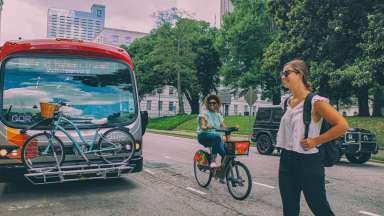Jump To:
Electric Vehicle (EV) Charging
EVs are a critical part of reducing Raleigh’s GHG emissions. More than 10,000 EVs are already rolling along Wake County and Raleigh streets, and the number is growing every year.
Over 90 percent of charging happens at home, so access to home charging is important to broaden access to the benefits of EVs. These include higher reliability, less maintenance, lower fuel costs, and participation in the transition to clean transportation.
However, most Raleigh residents do not have convenient access to EV charging. This creates barriers to purchasing an EV and limits the benefits to a smaller number of people, generally those who live in a single-family home.
That limitation particularly affects the more than 200,000 Raleigh residents who do not live in single-family homes. Apartment residents and renters generally do not have the ability to install their own chargers, and often do not have an option to charge at their workplace.
The ordinance would ensure that new apartment buildings could easily add EV charging in the future by ensuring that electrical capacity is in place. The term for this is called “EV Capable.” See the graphic above for more information. The ordinance is not requiring the installation of chargers, but that the capacity to easily install future chargers be included during construction. In the long term, this saves money for building owners because they can add chargers as the need grows without having to dig up parking lots and perform future costly electrical upgrades.
In addition to apartments, the ordinance would also apply to new hotels, gas stations, and standalone parking lots to further support EV charging options. This ordinance does not apply to existing locations, only new developments.
Drive-thrus
While drive-thrus are a convenient way to get food or make other purchases, they have drawbacks, especially in places where people could otherwise walk, use a wheelchair, stroller, scooter or bike more safely and comfortably. If you think about places you’ve been that were pleasant to walk in, they probably had few, if any, drive-thrus.
Idling in drive-thrus also contributes to health and financial costs. Not only does idling create air pollution and increase GHG emissions, it costs money. An idling truck or SUV can use a half gallon of gas or more per hour. Depending on how often we go to a drive-thru, going inside instead of sitting in a line might pay for a cup of coffee each week. Lastly, drive-thrus also occupy significant amounts of land (see image below) that could be used for additional housing and employment opportunities.
The ordinance addresses these issues by limiting new drive-thru construction in the most accessible and walkable parts of the city. These include downtown and other areas where we are trying to increase mobility options for people such as Hillsborough Street, the Village District, North Hills and other parts of Raleigh both inside and outside the Beltline. The goal is getting you to enjoy everything Raleigh has to offer outside of the car!
Existing drive-thrus would not be affected by this ordinance. New pharmacy drive-thrus also would still be allowed.
Pedestrian Connections
Making it easy to walk to nearby destinations improves community health, increases pedestrian safety, and reduces GHG emissions and other air pollutants. However, often there is no direct sidewalk connection between more residential neighborhoods and destinations such as grocery stores, greenways, parks, offices, or schools.
A typical example of this and how a lack of pedestrian connections reduces walkability and increases driving is shown in the image above.
Raleigh does ensure that sidewalks are built along public streets when new development takes place. However, this doesn't address what happens when, for example, an apartment and a shopping center are "back to back," rather than next to each other. The ordinance would address this issue by ensuring that connecting sidewalks are built when new development takes place. It will also ensure that new apartments or subdivisions have access to nearby greenways and to other destinations.
Existing developments would not have to add new sidewalks. However, as shopping centers and other areas are redeveloped, the ordinance would apply.
